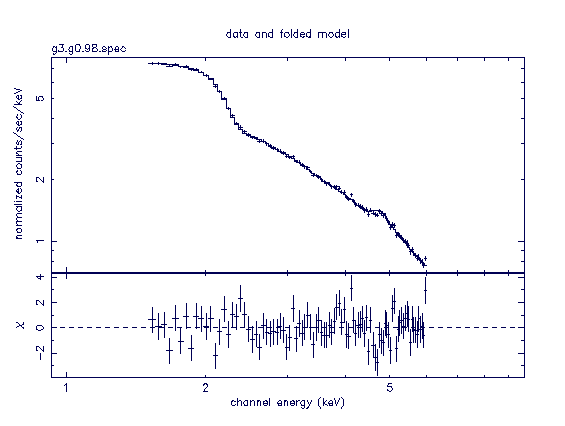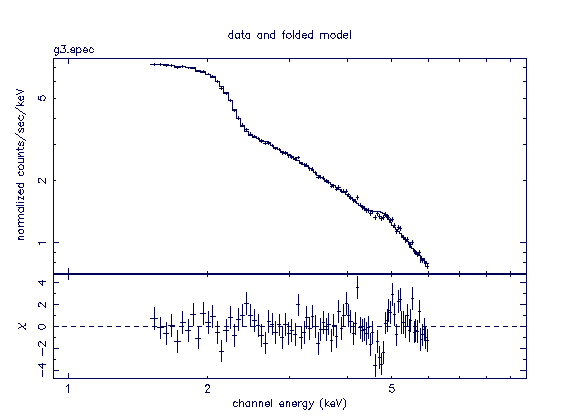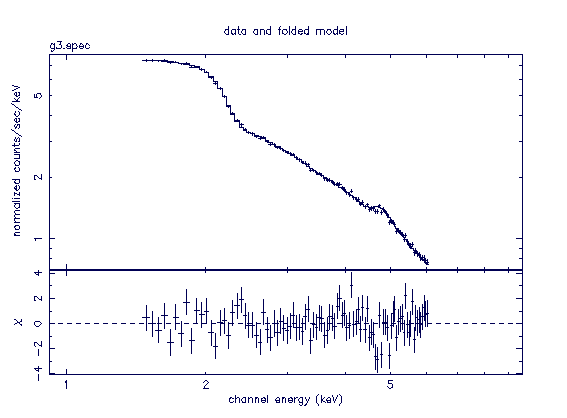GIS gain manual adjustment (July 19, 1996)
It has been announced by the GIS team that GIS gain can be incorrect in some cases beyond the usually expected uncertainties (see also the GIS calibration uncertainties ). In this document, we explain how to adjust GIS gains using ascalin (v0.9r and newer), when users encountered the GIS gain problem. This method can be also used to adjust SIS gain.
The following example is GX339-4 observed in September 8, 1995 (counting rate is about 20 cts/s/GIS). The first figure shows the original GIS3 energy spectrum in 1.5 - 6 keV fitted with a broken power-law plus absorption.

Because of the artificial gain shift, deviations are clearly seen at around the 2.2 keV (Gold M-edge) and 4.8 keV (Xe L-edge) instrumental spectral structures.
The following figure shows the spectrum after redistributing counts in the spectral file so that the new PI (pulse-invariance) channels corresponds to the 0.98 times the original channels.

The instrumental features become much weaker, and it is guessed that the correct gain is 0.98 times the original one. Please note that redistributing counts in the spectral file is not a precise method to cope with this problem, since this process will introduce additional unknown errors.
Below, we show a result using the xspec 'gain' command for the original spectrum. With the gain=1.023 and offset=0, the 2.2 keV feature almost disappears. Note that 1.023 is nearly 1/0.98 (xspec changes energy scale of the model, not the data).

Please be careful that xspec 'gain' command does not correct the Xe-L feature at 4.8 keV. This is because the Xe-L feature is in the RMF , although the 2.2 keV Au-M feature is in the ARF . To demonstrate this point, please look at the following figure in which we used gain=1.2. Note that the Au-M feature in the model moves toward higher energies, but Xe-L feature does not move.

A correct way to adjust gain is to assign new PI values to the original event file. The new ascalin (v0.9r and newer ) has this capability. An example of the command to do this is the following.
ascalin datafile=ad43001000g300370l.unf calfile=caldb tempofile=ft950908_0323_0800.ghf attitude=none gainnorm=1.023Thus PI values of event files are redetermined using gainnorm=1.023, which means the new PI values are 1/1.023 of the original ones. The new spectrum extracted from this event file seems normal, showing much smaller deviations at the 2.2 keV and 4.8 keV instrumental features (see below).

Please be careful that even when the GIS3 suffers from the gain problem, the calibration source peak appears at 5.97 keV, the energy expected when the gain is normal ( ASCA Newsletter vol 3, p. 11). The GIS3 gain problem is caused by an apparent inward shift of the calibration source. Because of the strong positional dependence of the gain (the gain is smaller outwards), the calibration source is assigned a smaller PI than real. The program which determines temporal gain (temp2gain) determines the temporal gain so that the smaller PI values of the calibration source corresponds to the expected energy (5.97 keV).
Hence, larger than real temporal gain values are written in the gain history file, and events from the X-ray source, which are taken near the center of the detector, are assigned larger PI values. Therefore, after reassigning the PI values so that the source energy spectrum becomes normal, the calibration peak will appear at a lower energy. In the case above, the new calibration peak appears at 5.84 keV after the gain correction.
If you have any questions concerning ASCA, visit our Feedback form.

